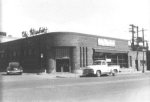
Despite the
economic depression of the 1930s, peach production remained fairly
profitable. Palisade was the major peach orchard zone, but the Redlands and
Bridgeport also had extensive production. Fruit picking sacks, with a bottom
which opened easily for emptying, were invented in Palisade by Nancy Brown. The Mountain
Lion Fruit label adorned millions of boxes. Wooden baskets also were used
widely.
There were many pear orchards as well, chiefly around Clifton.
The 1930s
